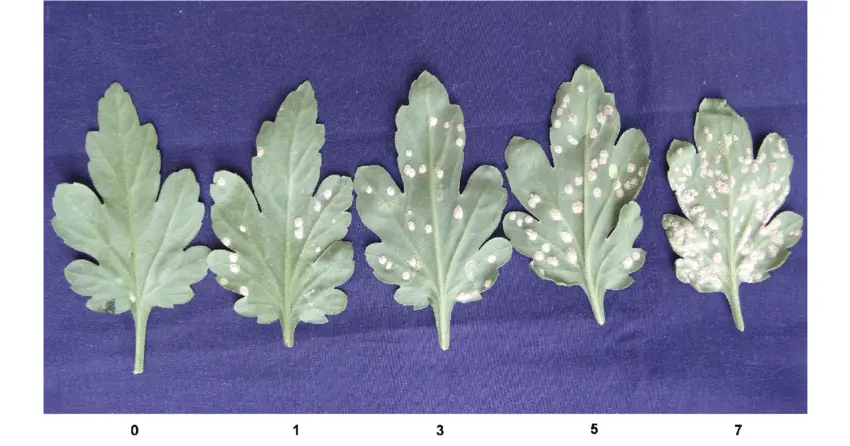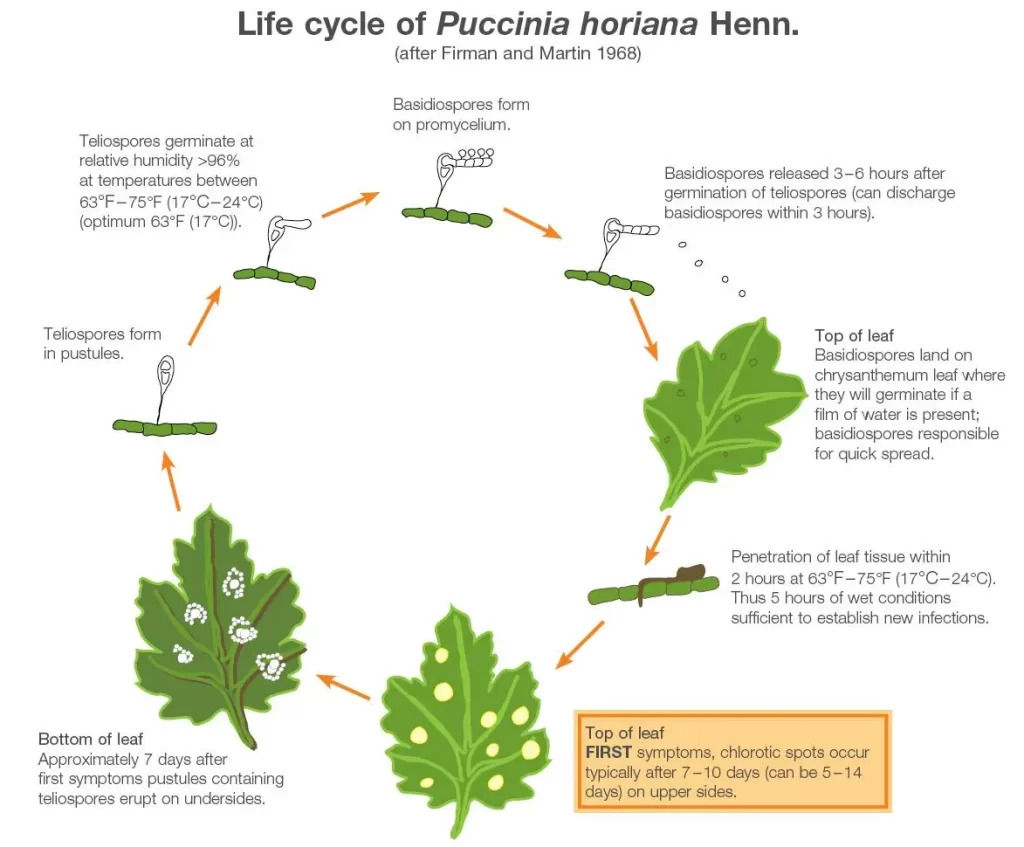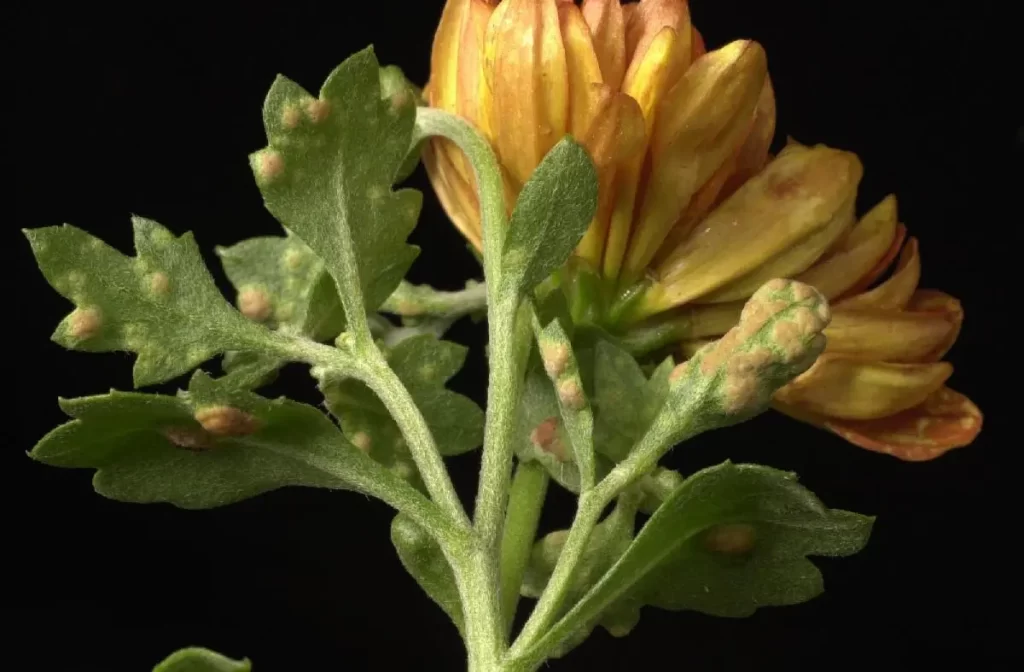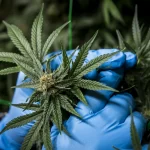Puccinia horiana
Introduction: A fungal threat to floricultural crops
This week, Healthy Hydroponics is shifting focus to cover a fungal pathogen, Puccinia horiana, commonly known as chrysanthemum white rust, that is known to affect chrysanthemum plants and daisies [1]. Belonging to the order Pucciniales, this pathogen poses a significant threat to the global chrysanthemum industry due to its ability to cause severe damage to the foliage and flowers of infected plants. Infection of the fungus in chrysanthemum plants can be highly destructive, and up to 80 to 100% of plants can become infected during outbreaks [2]. Puccinia horiana is characterized by the formation of distinctive white pustules on the leaves, stems, and flower buds of chrysanthemum plants, leading to leaf yellowing, defoliation, and, ultimately, reduced plant vigor and yield [3].
First identified in Japan in the early 1900s, Puccinia horiana has since spread to several countries worldwide, including the United States, Europe, and parts of Asia [4]. It is primarily transmitted through the airborne dispersal of its spores, making it highly contagious and easily capable of causing epidemics within chrysanthemum-growing regions [3]. Efforts to control and manage this fungal pathogen involve a combination of cultural practices, such as crop rotation and sanitation measures, as well as the application of fungicides. Continuous research and surveillance are crucial to understanding the biology and epidemiology of Puccinia horiana and developing effective strategies to mitigate its impact on chrysanthemum cultivation.
Table 1: Common hosts and their susceptibility to Puccinia horiana
| Host Plant | Susceptibility |
|---|---|
| Chrysanthemum | Highly susceptible |
| Leucanthemum | Moderately susceptible |
| Tanacetum | Moderately susceptible |
| Argyranthemum | Moderately susceptible |
| Gazania | Partial resistance |
| Coreopsis | Partial resistance |
| Echinacea | Partial resistance |
We provide great overviews of many agricultural microorganisms. Subscribe to stay updated!
Symptoms of Chrysanthemum White Rust
Puccinia horiana is characterized by the appearance of white pustules on the surfaces of leaves, stems, and flower buds [5,6]. These pustules are powdery in texture and can cover large areas of the plant, giving it a whitish appearance. As the disease progresses, the affected leaves may show yellowing, chlorosis, and wilting, eventually leading to defoliation [5,7]. Infected flower buds may fail to open properly or become deformed, resulting in reduced aesthetic and economic value of the chrysanthemum crop.
Severe infections of Puccinia horiana can weaken the overall vigor of the plant, leading to stunted growth and reduced yield [5]. It is important to note that the severity of symptoms can vary depending on the cultivar, environmental conditions, and the stage of plant development at the time of infection. Early detection and prompt management strategies are crucial to minimize the impact of the fungus on chrysanthemum cultivation.

Life Cycle and Infection Stages of Puccinia horiana
The fungus is brought into a greenhouse through infected plant material and can look normal. However, the right environmental conditions can encourage the growth of Puccinia horiana. The fungus can also spread to uninfected plants via contaminated soil, litter, dead leaves, gardening equipment, clothes, shoes, and human contact. However, in order to spread, the fungus needs living host tissue [4].
Puccinia horiana produces two different types of spores. The first spore stage occurs as teliospores emerge from pulsates on the undersides of leaves [4]. These teliospores remain there until they are brushed off and spread to another plant [4]. These ‘resting’ spores can persist for up to 8 weeks. If conditions allow (cool, moist conditions), these teliospores can then develop into basidiospores. The life cycle of basidiospores is short-lived (approximately one hour) but can cause a lot of damage if under cool and moist conditions. Once the basidiospores spread, symptoms will then be seen within 5 to 14 days [4].
Teliospores: also known as teleutospores are a thick-walled resting spore of rust fungi that is borne in a fruiting structure [8].
Basidiospores: spores that are produced by mushrooms, puffballs, shelf fungi, rusts, smuts, and many other fungi [9].

Growth Conditions for Alternaria solani
Puccinia horiana thrives under specific growing conditions that are considered ideal for its development. To create favorable conditions for Puccinia horiana, several factors must be taken into account. Firstly, the temperature range should be between 10°C and 25°C (50°F to 77°F), with relative humidity exceeding 90% [10]. Adequate moisture is crucial for the pathogen’s growth and reproduction. Additionally, the presence of free water, such as morning dew or mist, further facilitates its spread. Puccinia horiana tends to thrive in environments with limited air circulation and crowded plantings, as these conditions contribute to increased humidity. To prevent the spread of this fungus, it is essential to carefully monitor these conditions and implement appropriate measures, such as improving ventilation and spacing between plants, while also ensuring proper plant hygiene and utilizing disease-resistant varieties.
Methods of Prevention and Control
Controlling Puccinia horiana, the chrysanthemum white rust requires a multi-faceted approach that incorporates cultural practices, sanitation measures, and the use of fungicides. Crop rotation is an important cultural practice that helps reduce the risk of disease buildup in the soil, as Puccinia horiana can survive on infected plant debris. Additionally, removing and destroying infected plant material, including leaves, stems, and flower buds is crucial for minimizing the spread of the pathogen [5]. Another approach to preventing the spread of Puccinia horiana includes testing asymptomatic plants. Samples can be taken of up to 10 leaves and sent to a lab for rt-qPCR analysis or sequencing-based analyses. The benefit of this is preventing the spread before symptoms can even be seen [6].
The application of fungicides is a common practice for managing Puccinia horiana outbreaks. Fungicides containing active ingredients such as triazoles, strobilurins, or dithiocarbamates have shown efficacy against this pathogen [7]. These fungicides can be applied preventively, starting at the early stages of plant growth, and continued on a regular schedule throughout the growing season to maintain protection. However, it is important to rotate fungicides with different modes of action to reduce the risk of developing fungicide resistance in the pathogen population [5].
Conclusion
Overall, an integrated approach combining cultural practices, sanitation measures, and appropriate fungicide applications is essential for effective control of Puccinia horiana and minimizing its impact on chrysanthemum production. Ongoing research and surveillance are necessary to develop sustainable and environmentally friendly strategies for managing this devastating fungal pathogen [7].
Disclaimer
The information we present in Pathogen Profile is based on collating published peer-reviewed scientific literature, and sources we think are reliable. This is by no means an exhaustive review of pathogens. Pathogen Profile gives a small glimpse of what is known about pathogens. We encourage growers to do more research on the pathogens concerning their crops and hydroponic systems. We are not plant pathologists; thus, the information presented in the Pathogen Profile should not be used as professional advice to treat pathogens or operate your system.
References
-
Noma, T., Colunga-Garcia, M., Brewer, M., Landis, J., & Gooch, A. (n.d.). Chrysanthemum white rust Puccinia horiana Michigan State University’s invasive species factsheets. Retrieved from http://www.pestalert.org/oprDetail.cfm?oprID=344
-
Demers, J. E., Crouch, J. A., & Castlebury, L. A. (2015). A multiplex real-time PCR assay for the detection of Puccinia horiana and P. chrysanthemi on chrysanthemum. Plant Disease, 99(2), 195–200. https://doi.org/10.1094/PDIS-06-14-0632-RE
-
Chrysanthemum White Rust. (2021). Retrieved from https://www2.gov.bc.ca/assets/gov/farming-natural-resources-and-industry/agriculture-and-seafood/animal-and-crops/plant-health/phu-chrysanthemumwhiterust_ss.pdf
-
Julie Callahan. (2015, August 14). Chrysanthemum White Rust. UMass Extension Greenhouse Crops and Floriculture Program. Retrieved from https://ag.umass.edu/greenhouse-floriculture/fact-sheets/chrysanthemum-white-rust#:~:text=Chrysanthemum%20white%20rust%20
-
Royal Horticultural Society. (2023, July 9). Chrysanthemum white rust. RHS Gardening. https://www.rhs.org.uk/disease/chrysanthemum-white-rust
-
(2020), PM 7/027 (2) Puccinia horiana. EPPO Bulletin, 50, 207-216. https://doi.org/10.1111/epp.12658
-
Gill, H. K., & DuBois, K. (2015). Fungicide impact on in vitro germination of basidiospores of Puccinia horiana, the causal agent of chrysanthemum white rust. Plant Health Progress, 16(1), 24-28. https://doi.org/10.1094/PHP-RS-14-0032
-
Britannica, The Editors of Encyclopaedia. (2016, November 7). Teliospore. Encyclopedia Britannica. https://www.britannica.com/science/teliospore
-
Basidiospores. (n.d.). Basidiospores. Retrieved July 12, 2023, from http://www.emlab.com/resources/fungal-library/basidiospores/
-
Seymour, C. P. (1977). Plant Pathology Circular No. 59A.
![]()
Tanya Irani is the COO/CMO of Healthy Hydroponics InnoTech





